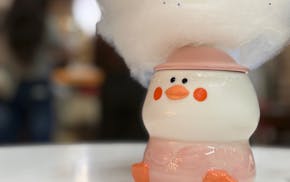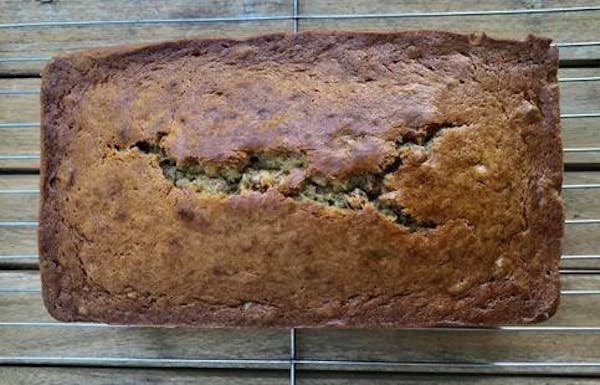Cinnamony Baked Apples
Serves 6.
Note: Calvados is apple brandy from France's Normandy region. If you don't have it, you can substitute apple juice, brandy or even water. From "The Silver Palate Cookbook: 25th Anniversary Edition" by Julee Rosso and Sheila Lukins.
• 2 1/4 c. brown sugar, divided
• 1 1/2 tbsp. ground cinnamon, divided
• 1 1/2 tbsp. freshly squeezed lemon juice
• 6 medium-to-large tart baking apples, washed (do not peel)
• 3/4 c. raisins
• 1/2 c. chopped pecans
• 1 tbsp. freshly grated lemon zest
• 3 tbsp. Calvados, divided (see Note)
• 3 tbsp. unsalted butter, cut into 6 pieces of equal size
Directions
Preheat oven to 375 degrees and line a 9- by 13-inch baking dish with parchment paper.
In a saucepan over medium-high heat, combine 2 cups water, 3/4 cup brown sugar, 1/2 tablespoon cinnamon and the lemon juice. Bring to a boil and cook for 3 minutes. Remove syrup from heat and reserve.
Remove the apple cores, but do not cut all the way through the bottoms.
In a medium bowl, combine the remaining 1 1/2 cups brown sugar, remaining 1 tablespoon cinnamon, raisins, pecans and lemon zest. Fill each apple with brown sugar mixture, to within 1/4 inch of the top. Pour 1 teaspoon Calvados over the filling in each apple and top with 1/2 tablespoon butter.
Transfer the apples to prepared baking dish. Stir the remaining 1 tablespoon Calvados into the reserved syrup and pour syrup over apples. Bake apples until tender, about 1 hour, basting them occasionally with the syrup in the pan.
Remove from oven and, using a slotted spoon, transfer baked apples to a serving dish. Pour the syrup from the pan into a small saucepan over medium-high heat. Bring to a boil and cook until slightly reduced, about 5 minutes. Cool slightly, then pour 1 tablespoon of syrup over each apple, and serve remaining syrup at the table.
Sour Cream Coffee Cake With Cinnamon Streusel
Serves 12.
Note: Author Tom Douglas notes that raspberries, blackberries or even pitted sweet cherries can be used instead of blueberries. Frozen berries do not need to be thawed. Adapted from "The Dahlia Bakery Cookbook."
For streusel:
• 1/2 c. flour
• 1/2 c. packed brown sugar
• 1 tsp. ground cinnamon
• 6 tbsp. (3/4 stick) cold unsalted butter, cut into dices
For cake:
• 2 1/2 c. flour
• 2 tsp. baking powder
• 1 tsp. baking soda
• 1 c. (2 sticks) unsalted butter, at room temperature, plus more for pan
• 1 c. plus 2 tbsp. granulated sugar, divided
• 3 eggs
• 1 c. sour cream
• 1 tbsp. vanilla extract
• 1 tsp. kosher salt
• 2 c. berries, fresh or frozen
Directions
To prepare streusel: In a medium bowl, combine 1/2 cup flour, brown sugar and cinnamon. Add 6 tablespoons butter and, using a pastry blender or your fingers, blend until mixture is crumbly. Reserve.
To prepare cake: Preheat oven to 350 degrees. Butter the bottom and sides of a 9- by 13-inch baking pan.
In a large bowl, sift together 2 1/2 cups flour, baking powder and baking soda.
In an electric mixer on medium-high speed, beat 1 cup butter and 1 cup granulated sugar until light and fluffy, about 2 to 3 minutes. Scrape down the bowl. Add eggs, 1 at a time, beating well after each addition and scraping the bowl down as needed. Add the sour cream, vanilla extract and salt, mixing until well-incorporated. Reduce speed to low and add the flour mixture in thirds, mixing just until everything is blended together. Gently fold in berries (the batter will be thick).
Scrape batter into prepared pan and spread it evenly with a spatula. Sprinkle streusel mixture evenly over batter. Sprinkle remaining 2 tablespoons granulated sugar over streusel. Bake until the top of the cake is golden brown and a skewer inserted into the center of the cake comes out with a few crumbs clinging but no batter, about 45 to 50 minutes, rotating the pan halfway through baking. Remove from oven and transfer pan to a wire rack to cool for at least 10 to 15 minutes. Cut cake into squares and serve warm.
Catherine David's Banana Bread
Makes 1 loaf.
Note: To toast walnuts, place the nuts in a dry skillet over medium heat, and cook, stirring (or shaking the pan frequently) until they just begin to release their fragrance, about 3 to 4 minutes (alternately, preheat oven to 325 degrees, spread the nuts on an ungreased baking sheet and bake, stirring often, for 4 to 6 minutes). Banana bread is remarkably adaptable. Add a half cup of a whole range of ingredients: chopped bittersweet or semisweet chocolate, unsweetened cocoa, shredded coconut, pitted and chopped dates, or chopped (and toasted) pecans, macadamia nuts, pistachios or unsalted peanuts. If you have unflavored yogurt, sour cream or buttermilk, add 1/4 cup after beating in the eggs, which will make the cake more moist and rich. No brown sugar? Just use 2/3 cup granulated sugar instead. If you have whole wheat flour on hand, substitute 1/2 cup of the all-purpose flour with whole wheat flour. Or follow the directions as is.
• 1 3/4 c. flour, plus extra for pan
• 2 tsp. baking powder
• 1/4 tsp. baking soda
• 1/2 tsp. salt
• 1/2 c. (1 stick) unsalted butter, at room temperature, plus extra for pan
• 1/3 c. packed brown sugar
• 1/3 c. granulated sugar
• 2 eggs, well beaten
• 1 tsp. vanilla extract
• 1 c. mashed very ripe bananas (2 to 3 bananas)
• 1/2 c. chopped and toasted walnuts (see Note)
Directions
Preheat oven to 350 degrees and butter the bottom and sides of a 5- by 9- by 3-inch loaf pan, then dust with flour, tapping out any excess.
In a medium bowl, sift together flour, baking powder, baking soda and salt, and reserve.
In a bowl of an electric mixer on medium-high speed, beat butter, brown sugar and granulated sugar until light and fluffy, about 2 to 3 minutes. Add eggs and vanilla extract and beat until thoroughly combined. Reduce speed to low and add flour mixture in thirds, alternating with mashed bananas and beginning and ending with flour mixture, mixing only until just combined. Fold in walnuts.
Scrape batter into prepared pan and bake until nicely browned and a tester inserted into the center of the bread comes out fairly clean (with bananas, this bread is moister than most). Remove from oven and transfer pan to a wire rack to cool for 15 minutes before removing from pan.
Butterscotch Pudding
Serves 6.
Note: If whole milk is unavailable, substitute 2 % milk. From "Cooking for Comfort," by Marian Burros.
• 2 tbsp. unsalted butter
• 1 1/2 c. packed dark brown sugar
• 4 c. whole milk, divided
• 3 tbsp. cornstarch
• 1/2 tsp. salt
• 4 eggs
• 1 tbsp. coffee liqueur (such as Kahlúa), optional
• Freshly whipped cream for garnish, optional
Directions
In a saucepan over low heat, melt the butter, then stir in the brown sugar. Increase heat to high and cook until the mixture bubbles. Reduce heat to medium, stir in 3 cups milk and cook for about 5 minutes; the mixture will be a little thick.
In a small bowl, combine a little of the remaining 1 cup milk with the cornstarch to form a paste. Stir the remaining milk into the paste, then add the milk-cornstarch mixture to the pan. Cook the mixture over medium heat until it thickens slightly, about 8 to 10 minutes. Stir in the salt.
In a medium bowl, beat the eggs. Pour a little of the hot mixture into the eggs, whisking well, and continue until the eggs are warm. Whisk the warmed egg mixture into the pudding mixture and continue to cook, bringing to a boil and whisking constantly. Cook until thickened, about 4 to 5 minutes.
Remove from heat and stir in coffee liqueur (optional). Spoon pudding into 6 cups or small bowls, and refrigerate. Serve cold, garnished with whipped cream, if desired.
World Peace Cookies
Makes about 3 dozen cookies.
Note: This dough must be prepared in advance. For additional flavor, add 1/2 teaspoon espresso powder with the cocoa. "I once said I thought these cookies, the brainchild of Parisian pastry chef Pierre Hermé, were as important a culinary breakthrough as Toll House cookies, and I've never thought better of the statement," writes Dorie Greenspan in "Baking: From My Home to Yours." Greenspan initially introduced these members of the sablé family in her "Paris Sweets" cookbook, but under a different name: Korova Cookies. Her neighbor believed that a daily bite of these easy-to-prepare cut-and-bake cookies "is all that is needed to ensure planetary peace and prosperity," wrote Greenspan. "I prefer them at room temperature, when the textural difference between the crumbly cookie and the chocolate bits is greatest."
• 1 1/4 c. flour
• 1/3 c. unsweetened cocoa powder
• 1/2 tsp. baking soda
• 1/2 c. plus 3 tbsp. (1 stick plus 3 tbsp.) unsalted butter, at room temperature
• 2/3 c. light brown sugar
• 1/4 c. granulated sugar
• 1/4 tsp. fine sea salt (or 1/2 tsp. fleur de sel)
• 1 tsp. vanilla extract
• 5 oz. bittersweet chocolate, chopped into chip-size pieces (roughly 3/4 c.)
Directions
In a medium bowl, sift the flour, cocoa and baking soda together, and reserve.
In a bowl of an electric mixer on medium speed, beat butter until soft and creamy, about 1 minute. Add brown sugar, granulated sugar, salt and vanilla extract, and beat for 2 additional minutes.
Reduce speed to low, add flour mixture and mix until just combined, working the dough as little as possible. Fold in chocolate pieces.
Turn the dough out onto a clean work surface. Gather dough together and divide it in half. Working one half at a time, shape the (sticky) dough into logs that are 1 1/2 inches in diameter. Wrap the logs in plastic wrap and refrigerate for at least 3 hours (dough can be refrigerated for up to 3 days or frozen for up to 2 months; if using frozen dough, no need to defrost, just slice the logs into cookies and bake 1 minute longer).
When ready to bake, preheat oven to 325 degrees and line baking sheets with parchment paper.
Using a sharp, thin knife, slice the logs into rounds that are 1/2 inch thick (the rounds are likely to crack as you're cutting them; just squeeze the bits back into each cookie) and place 1 inch apart on prepared baking sheets. Bake cookies 1 sheet at a time for 12 minutes. They won't look done, nor will they be firm, but that's just the way they should be. Remove from oven and cool 2 minutes before transferring cookies to a wire rack. Serve warm or at room temperature.

The 5 best things our food writers ate this week

A Minnesota field guide to snow shovels: Which one's best?

Summer Camp Guide: Find your best ones here

Lowertown St. Paul losing another restaurant as Dark Horse announces closing

